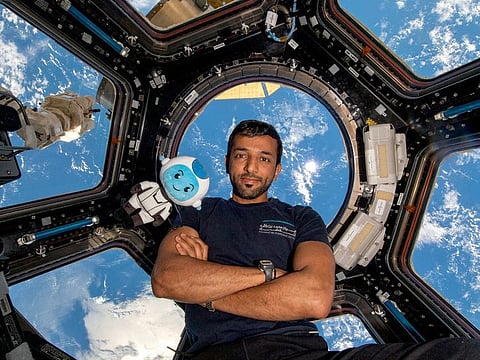450 sunrises and sunsets: UAE astronaut Sultan Al Neyadi completes one month in space
More research awaits flight engineer in remaining 5 months on longest Arab space mission

Dubai: UAE astronaut Sultan Al Neyadi has completed one month on the International Space Station (ISS) where he is conducting several scientific experiments and research.
The Najmonaut (Arab astronaut) who is on the longest Arab space mission lasting for six months, took to social media to mark the milestone and announced that he and his crewmates of NASA SpaceX Crew-6 have made significant progress in the experiments and research for their mission.
Al Neyadi, 41, launched into space along with 3 other Crew-6 members on a SpaceX Falcon-9 rocket on March 2.
The Crew Dragon Endeavour carrying Al Neyadi, along with NASA astronauts Stephen Bowen and Woody Hoburg and Andrey Fedyaev of Roscosmos, had automatically docked to the Harmony module of the ISS at 10:40am UAE time on March 3.
Recollecting the launch, Al Neyadi tweeted: “A month ago, we launched from Cape Canaveral, Florida and began our journey into space. Since then, we have witnessed more than 450 sunrises and sunsets, and made significant progress in the experiments and research for our mission.”
While rotating the Earth every 90 minutes, astronauts on the ISS witness 16 sunrises and sunsets every 24 hours. Al Neyadi has so far witnessed more than 450 sunrises and sunsets.
The Emirati astronaut also expressed how he is carrying forth the UAE Space Mission named after the founding father of the country, the late Sheikh Zayed bin Sultan Al Nahyan. “United with my crew, we continue to work towards achieving our scientific goals. From Earth to space, I proudly carry forth Zayed’s Ambition,” Al Neyadi wrote as he posted daylight images of the UAE from the ISS.
Swinging into action
Travelling at 28,000km/hr in an orbit 400km above the Earth, Al Neyadi got up to speed with life on orbit soon after his historic launch. The Emirati flight engineer and the other Crew-6 members familiarised themselves with the space station operations and systems in the first few days.
Soon, Al Neyadi also swung into action, harvesting tomatoes, collecting them for both scientific analysis and crew consumption for the Veg-05 space botany study which addresses the need for a continuous fresh-food production system in space.
Al Neyadi also installed space biology hardware and replaced electronic components in the first week itself.
He has been a subject of several studies and his science experiments have been in full swing with studies on heart, sleep, food and medicines. Al Neyadi has also been busy doing maintenance works on the ISS including plumbing duties such as removing and replacing a toilet on the ISS.
Space to Ground calls
On March 7, he interacted with His Highness Sheikh Mohammed bin Rashid Al Maktoum, Vice President and Prime Minister of the UAE and Ruler of Dubai, in a live video call. He also addressed the students of GEMS Jumeirah College on the same day through a ham radio session. His next interaction was with around 2,000 residents at Dubai Opera on March 21 in the first episode of the Mohammed Bin Rashid Space Centre’s nation-wide initiative ‘A Call With Space.’
One of his favourite activities on the ISS has been getting behind the lens for Earth observation, capturing breathtaking sights than can only be witnessed from space. The images that he captured from the Cupola of the ISS include some stunning visuals of the UAE, Egypt and Sahara Desert.
Al Neyadi’s recorded video sessions have been used in the ELF in Space programme through which school students are learning more about space explorations.
During the past month, Al Neyadi also had his first hair cut in space, posed a space trivia and shared posts that urge people to preserve water, our planet Earth and the need for exercising especially in space.
Also Read: Sultan Al Neyadi demonstrates benefits of exercise on ISS on first episode of ELF in Space
Also Read: Will UAE astronaut Sultan Al Neyadi do a spacewalk? His backup Hazzaa Al Mansoori answers
From Expedition-68 to 69
While living and working aboard the orbital outpost with the 11-member Expedition 68, Al Neyadi shared a wonderful time with the Crew-5, four of whom returned to Earth in the second week of March.
The Crew-6 quartet are now part of the Expedition 69 which includes NASA astronaut Frank Rubio and Roscosmos cosmonauts Sergey Prokopyev and Dmitri Petelin.
The Expedition 69 experiments include studying how particular materials burn in microgravity to keep spacecraft safe, testing a new tool for deep-space immune monitoring in orbit, continuing work with 3D-cultured cardiac muscle tissue to assess human cardiac function in microgravity, and testing samples for microorganisms from outside of the space station.
Sign up for the Daily Briefing
Get the latest news and updates straight to your inbox


